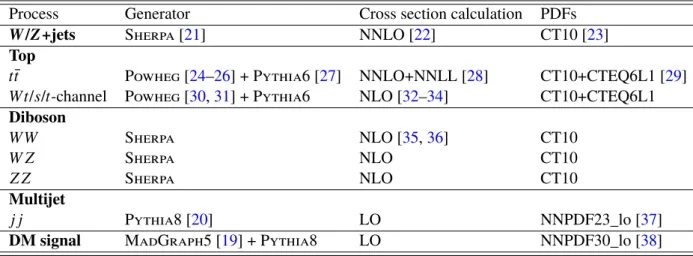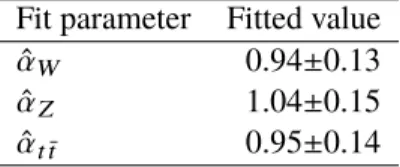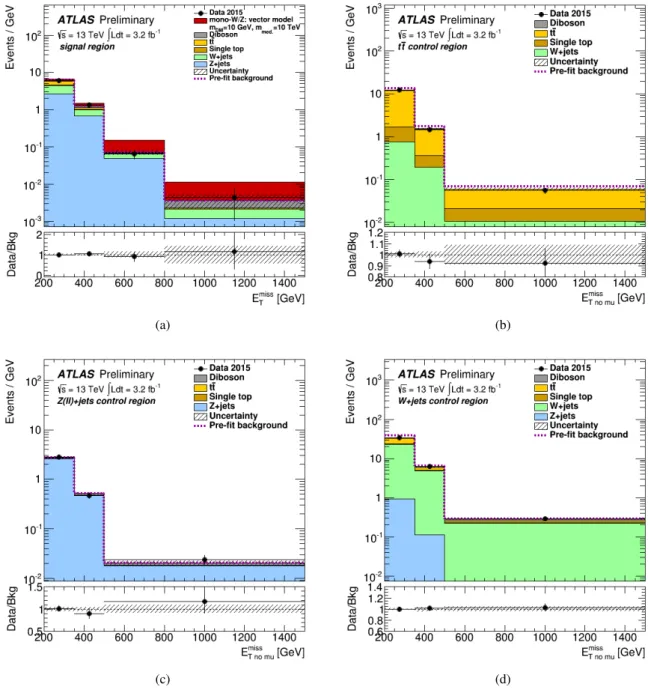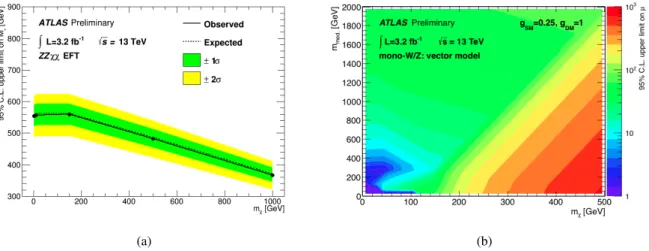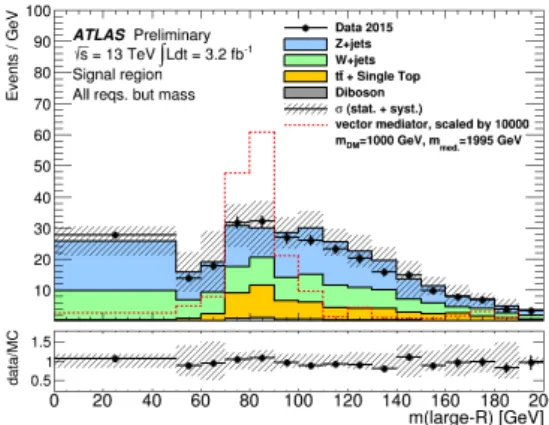ATLAS-CONF-2015-080 15December2015
ATLAS NOTE
ATLAS-CONF-2015-080
15th December 2015
Search for dark matter produced in association with a hadronically decaying vector boson in p p collisions at √
s = 13 TeV with the ATLAS detector at the LHC
The ATLAS Collaboration
Abstract
This note describes a search for dark matter produced in association with a hadronically- decayingW or Z boson using 3.2 fb−1 of pp collisions at
√s = 13 TeV recorded by the ATLAS detector at the Large Hadron Collider. The topology of this search is a boosted boson recoiling against pair-produced dark matter particles, producing a large-radius jet and missing transverse momentum. No statistically significant excess over the Standard Model prediction is observed. The search results are interpreted in terms of both an effective field theory and a simplified model containing dark matter.
© 2015 CERN for the benefit of the ATLAS Collaboration.
Reproduction of this article or parts of it is allowed as specified in the CC-BY-4.0 license.
1 Introduction
Dark matter (DM) composes a large part of the mass-energy of the universe, but its nature and interactions with the Standard Model (SM) as well as many of its properties remain unknown. If DM couples to SM particles it may be observed if it is directly produced in a particle collider, when galactic DM particles co- annihilate (indirect detection), or induce nuclear recoils in deep underground detectors (direct detection).
Collider production of DM particles, if possible, does not suffer from the astrophysical uncertainties that affect direct and indirect detection experiments. The signature at the Large Hadron Collider (LHC) [1]
is one or more SM particles,X, recoiling against weakly-interacting DM particles, χ, which manifest as missing transverse momentum,Emiss
T . Previous LHC analyses have studied DM produced in association with a hadronic jet [2,3], a photon [4,5], a hadronically decayingW orZ [6], a leptonically decayingW orZ [7–10], a heavy-flavor quark [11], and a Higgs boson [12,13].
Two approaches are commonly used to model these processes yielding a final state with a detectable particle X (e.g. aW or Z boson) recoiling against a system of non-interacting particles. One method is to use non-renormalizable operators in an effective field theory (EFT) framework, where the mediator of the interaction between DM particles and SM particles is too heavy to be produced directly in the experiment and is therefore described by contact operators. Simplified models do not have this limitation on the mediator mass because they explicitly include a specific mediator, V. An EFT requires fewer free parameters to describe its parameter space, but it may not be valid for the exchanged momentum values typical for the LHC. Following the Dark Matter Forum report recommendation [14], this analysis focuses on theZ Zχ χEFT [15] and the vector-mediated simplified model [16]. Figure1shows diagrams illustrating each approach. This search is based on proton–proton collision data at a center-of-mass energy of 13 TeV produced by the LHC and recorded with the ATLAS detector [17] in 2015, corresponding to an integrated luminosity of 3.2 fb−1.
q
q
Z
Z
χ
χ (a)
q
q W, Z χ
χ V
(b)
Figure 1: (a) Example of dark matter particle (χ) production via a Z Zχ χ vertex in an EFT approach [15]; (b) example of dark matter particle production via a vector mediator, V, between the dark sector and the SM in association with aW/Z boson in a simplified model [16].
2 The ATLAS detector
The ATLAS detector is a general-purpose detector with an inner tracking system, electromagnetic and hadronic calorimeters, and a muon spectrometer surrounding the interaction point.1 The inner tracking system is immersed in a 2 T axial magnetic field, and the muon spectrometer employs a toroidal magnetic field. In this analysis only data recorded with all sub-detector systems fully operational are used. A two level trigger system is used. The first level selects events with custom-made hardware and uses coarse-granularity calorimeter and muon information. The second level is based on software algorithms and uses the full detector granularity.
3 Simulated samples
All signal and background processes are modeled with Monte Carlo (MC) simulation. Geant4 [18] models the interactions between particles and the detector. Signal processes are modeled with MadGraph5 [19], and underlying event and parton showering is simulated with Pythia8 [20]. Two models are considered in this note: 7-dimensional Z Zχ χ EFT and a vector mediated simplified model. The strength of the EFT interaction is controlled by the mass scale,M?, and the strength of the simplified model interaction is controlled by the product of the couplings of the mediator to the SM and the DM sectors,gSMgDM. The EFT model samples were generated withM? = 3000 GeV, and the simplified model samples were generated with couplingsgSM = 0.25 andgDM =1. Samples are generated as a function of dark matter particle mass,mχ for the EFT and in a grid of mediator mass,mmed., andmχ for the simplified model.
Table1summarizes the MC generators, parton distribution functions (PDFs), and the order of the cross section calculation in QCD used in this analysis. The estimation of the dominant W/Z+jets and t¯t backgrounds is improved using dedicated control regions in data.
4 Object reconstruction
The final state consists of a boosted, hadronically-decayingWorZboson recoiling against pair-produced dark matter particles, manifesting in the detector as a single, large-radius (large-R) jet [39,40]. Therefore, selected events are composed of at least one large-Rjet, highEmiss
T , and no leptons.
Three jet definitions are employed. Two of them (“large-R” and “small-R”) are based on the reconstruction of calorimeter energy clusters, and the third (“track jets”) is based on inner detector tracks. Large-Rand small-Rjets are distinguished based on the jet clustering distance parameter. Small-Rjets and track jets are used to reject multi-jet background and define control regions, respectively. The four-vector of all three types is calculated from the vectorial sum of the constituents grouped together using the anti-kT jet clustering algorithm [41].
Large-Rjets are reconstructed with an anti-kT distance parameter R=1.0. To remove energy deposited from pileup jets, the underlying event, and soft radiation, large-Rjets are trimmed [42]. In this process,
1The ATLAS experiment uses a right-handed coordinate system with its origin at the nominal interaction point (IP) in the center of the detector and thez-axis along the beam pipe. Thex-axis points from the IP to the center of the LHC ring, and the y-axis points upward. Cylindrical coordinates(r, φ)are used in the transverse plane,φbeing the azimuthal angle around the z-axis. The pseudorapidity is defined in terms of the polar angleθasη=−ln[tan(θ/2)]. Transverse momenta are computed from the three-momenta,p, aspT=|p|sinθ.
Table 1: List of the MC generators, the order of cross section calculation in QCD, and parton distribution functions (PDFs) used in the generation of signal and background processes.
Process Generator Cross section calculation PDFs
W/Z+jets Sherpa [21] NNLO [22] CT10 [23]
Top
tt¯ Powheg [24–26] + Pythia6 [27] NNLO+NNLL [28] CT10+CTEQ6L1 [29]
W t/s/t-channel Powheg [30,31] + Pythia6 NLO [32–34] CT10+CTEQ6L1 Diboson
W W Sherpa NLO [35,36] CT10
W Z Sherpa NLO CT10
Z Z Sherpa NLO CT10
Multijet
j j Pythia8 [20] LO NNPDF23_lo [37]
DM signal MadGraph5 [19] + Pythia8 LO NNPDF30_lo [38]
large-Rjets are reclustered using thekT algorithm [43] with distance parameterRsub =0.2, and sub-jets with transverse momentum pT less than fcut = 5% of the large-R jet pT are removed. The large-Rjet four-momentum is calibrated to hadron level with scale factors derived from simulation. Large-Rjets are required to satisfypT > 200 GeV and|η| <2.0.
Large-R jets are classified as originating from aW or a Z boson using a jetpT-dependent selection on the jet mass and the jet substructure variable, D2[44,45], which selects jets with two concentrations of energy [46, 47]. The D2 selection is adjusted as a function of jet pT to selectW or Z bosons with a constant 50% efficiency using simulated samples enriched withW orZ bosons. The width of the mass window is fixed to 30 GeV while its center varies as a function of jetpT.
Small-Rjets withR =0.4 are used to reduce background events from multi-jet processes. Small-Rjets within|η| < 2.5 are required to satisfy pT > 20 GeV, and those within 2.5 < |η| < 4.5 are required to satisfypT >30 GeV. The small-Rjets satisfyingpT <50 GeV and|η| < 2.4 are required to be associated to the primary vertex using a likelihood-based method that takes into account tracking information to reduce contamination from pileup jets [48]. Calibration of the jet energy and the concomitant systematic uncertainties on the calibration constants are estimated with studies performed with
√s=8 TeV data and simulation and checked against
√s =13 TeV simulation [49–51].
Track jets are used to identify events containing b-hadrons. They are reconstructed using the anti-kT algorithm with R = 0.2 from inner detector tracks constrained to originate from the primary vertex through impact parameter requirements. Track jets are required to satisfy pT > 10 GeV and |η| < 2.5.
Track jets containing b-hadrons are identified based on the properties of their constituent tracks, in particular the track impact parameters and the presence and properties of displaced vertices using the MV2c algorithm [52–54]. The working point chosen has 70% efficiency to identify jets containingb- hadrons in a simulated sample oft¯t. Only track jets not associated to the leading large-Rjet via the ghost association process [55] are used to classify events, in order to avoid countingb-hadrons produced in Z boson decays.
Muon candidates are categorized as loose, medium, and tight, while a single, loose electron category is used. These categories are defined in the following paragraphs. In the signal selection, SM background processes producing leptons are effectively eliminated by rejecting events containing any loose leptons.
To define control regions enriched in such processes, one or two muons passing the medium or tight criteria are required instead.
Electron candidates are reconstructed from particle showers that primarily deposit their energy in the electromagnetic calorimeter. The electromagnetic calorimeter energy clusters must be matched to an inner detector track. They are identified using a likelihood-based procedure [56,57]. Loose electrons must satisfy the “very loose likelihood” identification criteria and are required to satisfypT >7 GeV and
|η| <2.47. The inner detector track matched to the calorimeter cells must be loosely isolated from nearby track activity and its impact parameter must be consistent with originating from the primary vertex.
Muon candidates are reconstructed from a combined fit of inner detector hits and and muon spectrometer segments [58]. Loose muons are required to satisfy pT > 7 GeV and |η| < 2.7. The inner detector track associated to the muon spectrometer segment must satisfy the same isolation and impact parameter requirements as imposed on loose electrons. Medium muons must meet additional requirements on transverse momentum and pseudorapidity,pT> 25 GeV and|η| <2.5. Tight muons must satisfy a tighter isolation requirement.
The missing transverse momentum vector,Emiss
T , is computed using reconstructed and calibrated physics objects, as well as reconstructed tracks originating from the primary vertex that are not associated with any object [59–61]. The missing transverse momentum calculated fully from inner detector tracks is called the track missing transverse momentum, pmiss
T . The vectorial sum of the missing transverse momentum (track missing transverse momentum) and the muon transverse momentum,Emiss
T,no mu(pmiss
T,no mu), is used in theW → µνandZ →µµcontrol regions. The muon momentum is excluded from the missing transverse momentum in the online trigger calculation.
5 Event selection
All events studied in this analysis are accepted by the 80 GeV Emiss
T trigger, which is fully efficient for Emiss
T > 200 GeV. The signal region definition requires no loose electrons or muons, Emiss
T > 250 GeV, and at least one large-R jet. The leading pT large-Rjet in the event must satisfy the W or Z jet mass and substructure requirements. Events with mismeasuredEmiss
T are reduced with three further selection requirements based on the pmiss
T , Emiss
T , and the small-R jet transverse momenta: pmiss
T > 30 GeV; the azimuthal angle between theEmiss
T and thepmiss
T ,∆φ(Emiss
T ,pmiss
T ) < π/2; and the angle between theEmiss
T
and the nearest small-Rjet min[∆φ(Emiss
T ,pjet
T )]> 0.6.
Three control regions are defined with no significant contribution from signal and that are enriched in the W boson, Z boson, and t¯t backgrounds. Events containing one or two muons are selected, and requirements on the number ofb-tagged track jets are imposed. The jet substructure requirement used is the same as in the signal region. The jet mass selection criterion is relaxed in order to increase the event yield, while keeping the selection requirements similar to those of the signal region.
Events with exactly two muons are selected in order to define the Z boson control region. One muon must pass the medium quality requirement, and the other must pass the loose quality requirement. The dimuon mass must be between 66 GeV and 116 GeV. The missing transverse momentum must satisfy Emiss
T,no mu > 200 GeV and pmiss
T,no mu > 30 GeV. There must be at least one large-R jet that passes the substructure requirement.
Events with one muon and nob-tagged track jets are selected for theW boson control region, and those with one muon and at least oneb-tagged track jet for thett¯control region. The muon must satisfy the tight quality requirement. The events must meet the same missing transverse momentum and large-Rjet requirements as those required for theZ boson control region.
6 Systematic uncertainties
Object reconstruction and identification efficiencies, momentum scale and resolution are sources of experimental systematic uncertainties.
The modeling of large-R jet parameters (D2, mass, and energy) presents the largest source of experi- mental systematic uncertainty; the scale and resolution are considered for each parameter. TheD2scale uncertainty and the mass resolution have the largest impact; they result in a variation on the signal and background yield of approximately 5-10% and a variation on the signal yield of about 10%, respectively.
The other systematic variations have a combined effect no larger than a few percent.
In contrast to the large-Rjets, only uncertainties on the small-Rjet energy are considered. These variations amount to a 5% uncertainty on the background yield and a few percent (2-3%) on the signal.
The lepton reconstruction and identification efficiency and energy scale and resolution have a sub-percent effect. The uncertainty in the measured integrated luminosity is estimated at 5% using special calibration data taking runs and techniques described in Ref. [62].
The background modeling uncertainties are evaluated by comparing the Emiss
T distributions between nominal and alternative generators. ForZ+jets andW+jets background, MadGraph samples have been used to compare with the nominal Sherpa samples; for the t¯t background, samples generated with aMC@NLO [19] interfaced to Herwig have been used to compare with the nominal POWHEG samples.
Since the distribution ofEmiss
T is found to be similar between the generators within statistical uncertainties, they are not considered in the final analysis. Signal modeling uncertainties are not considered.
7 Results
A profile-likelihood fit [63] to the Emiss
T distribution in the signal region and to Emiss
T,no mu in the control regions is used to constrain the primary backgrounds and extract the signal strength for each model, µ, an overall normalization factor on the signal prediction. Besides the signal strength, three overall normalization factors for the W boson, Z boson, andt¯t backgrounds are free parameters in the fit. The diboson and single-top backgrounds are estimated directly by simulation, and the multijet background is negligible. The likelihood function is defined as the product of Poisson distributions over all bins inEmiss
T
(orEmiss
T,no mu), and the likelihood is simultaneously maximized over the signal and control regions. The systematic variations of the expected signal and background are accomplished with nuisance parameters constrained by Gaussian probability distribution functions, and they are properly correlated across signal and background processes and regions.
A background-only fit, with µ fixed to zero, shows no deviation from SM predictions, and Figure 2 shows kinematic distributions after the profile-likelihood fit. The normalization factors obtained from the profile-likelihood fit are given in Table2, and the floating background normalization parameters are
Table 2: The post-fit values and uncertainties of the background normalization factors.
Fit parameter Fitted value
αˆW 0.94±0.13
αˆZ 1.04±0.15
αˆtt¯ 0.95±0.14
Table 3: Predicted and observed number of events in the signal region. The yields and uncertainties of the backgrounds are shown after the profile likelihood fit to the data.
Process events
Z+jets 519±31
W+jets 326±22
t¯tand single-top 217±18
Diboson 88±12
Total Background 1150±30
Data 1143
consistent with unity within less than one standard deviation. The number of events passing the final signal region selection are shown in Table3, where the values for the expectations and uncertainties are obtained from the fit.
The fit results are used to calculate 95% confidence level (C.L.) upper limits on µ using the CLs
method [64]. For the Z Zχ χ EFT, these limits are translated into constraints on the mass scale, M?. Figure3shows the limits onM?as a function ofmχ, and on the signal strength,µ, for the vector-mediated simplified model generated with couplingsgSM=0.25 andgDM =1.
(a) (b)
(c) (d)
Figure 2: TheEmiss
T (Emiss
T,no mu) distribution of the events in the signal region (control regions) after the profile- likelihood fit. Figure (a) shows the signal region, (b) thett¯control region, (c) theZ+jets control region, and (d) the W+jets control region. The inset at the bottom of each plot shows the ratio of the data to the total background. The signal expectation for the vector-mediated simplified model withmχ =10 GeV andmmed. =10 TeV is shown in sub-figure (a) on top of the background. The total background before the fit is shown as a dashed line. The hatched bands represent the total uncertainty on the background.
(a) (b)
Figure 3: Figure (a) shows the limit on the mass scale,M?, of the Z Zχ χEFT. Figure (b) shows the limit on the signal strength,µ, of the vector-mediated simplified model in the plane of the dark matter particle mass,mχ, and the mediator mass,mmed..
8 Conclusion
A search for dark matter has been performed in events having a large-R jet compatible with aW or Z boson and largeEmiss
T in the 2015 ATLAS dataset containing 3.2 fb−1of
√s =13 TeVppcollisions. No statistically significant excess is observed. These results are interpreted in the EFT and simplified model frameworks.
References
[1] L. Evans and P. Bryant,LHC Machine, Journal of Instrumentation3.08 (2008) S08001.
[2] ATLAS Collaboration,Search for new phenomena in final states with an energetic jet and large missing transverse momentum in pp collisions at√
s =8TeV with the ATLAS detector(2015), arXiv:1502.01518 [hep-ex].
[3] CMS Collaboration,Search for dark matter, extra dimensions, and unparticles in monojet events in proton-proton collisions at√
s= 8 TeV(2014), arXiv:1408.3583 [hep-ex].
[4] ATLAS Collaboration,Search for new phenomena in events with a photon and missing transverse momentum inppcollisions at√
s=8TeV with the ATLAS detector, Phys. Rev.D91.1 (2015) 012008, arXiv:1411.1559 [hep-ex]. [5] CMS Collaboration,
Search for new phenomena in monophoton final states in proton-proton collisions at√
s= 8 TeV (2014), arXiv:1410.8812 [hep-ex].
[6] ATLAS Collaboration,Search for dark matter in events with a hadronically decaying W or Z boson and missing transverse momentum inppcollisions at√
s=8 TeV with the ATLAS detector, Phys. Rev. Lett.112.4 (2014) 041802, arXiv:1309.4017 [hep-ex].
[7] ATLAS Collaboration,Search for dark matter in events with a Z boson and missing transverse momentum in pp collisions at√
s=8 TeV with the ATLAS detector, Phys. Rev.D90.1 (2014) 012004, arXiv:1404.0051 [hep-ex].
[8] ATLAS Collaboration,Search for new particles in events with one lepton and missing transverse momentum inppcollisions at√
s= 8 TeV with the ATLAS detector, JHEP1409(2014) 037, arXiv:1407.7494 [hep-ex].
[9] CMS Collaboration,Search for physics beyond the standard model in final states with a lepton and missing transverse energy in proton-proton collisions at√
s= 8 TeV(2014), arXiv:1408.2745 [hep-ex].
[10] CMS Collaboration,Search for dark matter and unparticles produced in association with a Z boson in proton-proton collisions at sqrt(s) = 8 TeV(2015), arXiv:1511.09375 [hep-ex]. [11] ATLAS Collaboration,Search for dark matter in events with heavy quarks and missing transverse
momentum inppcollisions with the ATLAS detector, Eur. Phys. J.C75.2 (2015) 92, arXiv:1410.4031 [hep-ex].
[12] ATLAS Collaboration,Search for Dark Matter in Events with Missing Transverse Momentum and a Higgs Boson Decaying to Two Photons inppCollisions at√
s =8TeV with the ATLAS Detector, Phys. Rev. Lett.115.13 (2015) 131801, arXiv:1506.01081 [hep-ex].
[13] ATLAS Collaboration,Search for dark matter produced in association with a Higgs boson decaying to two bottom quarks inppcollisions at√
s=8TeV with the ATLAS detector(2015), arXiv:1510.06218 [hep-ex].
[14] D. Abercrombie et al.,Dark Matter Benchmark Models for Early LHC Run-2 Searches: Report of the ATLAS/CMS Dark Matter Forum(2015), arXiv:1507.00966 [hep-ex].
[15] L. M. Carpenter et al.,
Collider searches for dark matter in events with a Z boson and missing energy, Phys. Rev.D87.7 (2013) 074005, arXiv:1212.3352 [hep-ex].
[16] O. Buchmueller et al.,Characterising dark matter searches at colliders and direct detection experiments: Vector mediators, JHEP01(2015) 037, arXiv:1407.8257 [hep-ph]. [17] ATLAS Collaboration,The ATLAS Experiment at the CERN Large Hadron Collider,
JINST3(2008) S08003.
[18] S. Agostinelli et al.,GEANT4: A Simulation toolkit, Nucl. Instrum. Meth. A506(2003) 250.
[19] J. Alwall et al.,The automated computation of tree-level and next-to-leading order differential cross sections, and their matching to parton shower simulations, JHEP07(2014) 079,
arXiv:1405.0301 [hep-ph].
[20] T. Sjostrand, S. Mrenna and P. Z. Skands,A Brief Introduction to PYTHIA 8.1, Comput. Phys. Commun.178(2008) 852, arXiv:0710.3820 [hep-ph]. [21] T. Gleisberg et al.,Event generation with SHERPA 1.1, JHEP0902(2009) 007,
arXiv:0811.4622 [hep-ph]. [22] K. Melnikov and F. Petriello,
Electroweak gauge boson production at hadron colliders throughO(α2s), Phys. Rev. D74(2006) 114017, arXiv:hep-ph/0609070.
[23] H.-L. Lai et al.,New parton distributions for collider physics, Phys. Rev. D82(2010) 074024, arXiv:1007.2241 [hep-ph].
[24] P. Nason,A New method for combining NLO QCD with shower Monte Carlo algorithms, JHEP0411(2004) 040, arXiv:hep-ph/0409146.
[25] S. Frixione, P. Nason and C. Oleari,
Matching NLO QCD computations with Parton Shower simulations: the POWHEG method, JHEP0711(2007) 070, arXiv:0709.2092 [hep-ph].
[26] S. Alioli et al.,A general framework for implementing NLO calculations in shower Monte Carlo programs: the POWHEG BOX, JHEP1006(2010) 043, arXiv:1002.2581 [hep-ph].
[27] T. Sjostrand, S. Mrenna and P. Z. Skands,PYTHIA 6.4 Physics and Manual, JHEP0605(2006) 026, arXiv:hep-ph/0603175.
[28] M. Czakon, P. Fiedler and A. Mitov,
Total Top-Quark Pair-Production Cross Section at Hadron Colliders ThroughO(a4S), Phys. Rev. Lett.110(2013) 252004, arXiv:1303.6254 [hep-ph].
[29] J. Pumplin et al.,
New generation of parton distributions with uncertainties from global QCD analysis, JHEP0207(2002) 012, arXiv:hep-ph/0201195.
[30] S. Alioli et al.,
NLO single-top production matched with shower in POWHEG: s- and t-channel contributions, JHEP09(2009) 111, [Erratum: JHEP02,011(2010)], arXiv:0907.4076 [hep-ph].
[31] E. Re,
Single-top Wt-channel production matched with parton showers using the POWHEG method, Eur. Phys. J.C71(2011) 1547, arXiv:1009.2450 [hep-ph].
[32] N. Kidonakis,Next-to-next-to-leading-order collinear and soft gluon corrections for t-channel single top quark production, Phys. Rev. D83(2011) 091503, arXiv:1103.2792 [hep-ph]. [33] N. Kidonakis,NNLL resummation for s-channel single top quark production,
Phys. Rev. D81(2010) 054028, arXiv:1001.5034 [hep-ph].
[34] N. Kidonakis,
Two-loop soft anomalous dimensions for single top quark associated production with a W- or H-, Phys. Rev. D82(2010) 054018, arXiv:1005.4451 [hep-ph].
[35] J. M. Campbell and R. Ellis,MCFM for the Tevatron and the LHC,
Nucl. Phys. Proc. Suppl.205-206(2010) 10, arXiv:1007.3492 [hep-ph].
[36] J. M. Campbell, R. K. Ellis and C. Williams,Vector boson pair production at the LHC, JHEP07(2011) 018, arXiv:1105.0020 [hep-ph].
[37] R. D. Ball et al.,Parton distributions with LHC data, Nucl. Phys.B867(2013) 244, arXiv:1207.1303 [hep-ph].
[38] R. D. Ball et al.,Parton distributions for the LHC Run II, JHEP04(2015) 040, arXiv:1410.8849 [hep-ph].
[39] ATLAS Collaboration,Identification of Boosted, Hadronically Decaying W Bosons and Comparisons with ATLAS Data Taken at√
s =8TeV(2015), arXiv:1510.05821 [hep-ex]. [40] ATLAS Collaboration,Identification of boosted, hadronically-decaying W and Z bosons in
√s=13 TeV Monte Carlo Simulations for ATLAS, ATL-PHYS-PUB-2015-033, url:https://cdsweb.cern.ch/record/2041461.
[41] M. Cacciari, G. P. Salam and G. Soyez,The anti-kT jet clustering algorithm, JHEP0804(2008) 063, arXiv:0802.1189 [hep-ph].
[42] D. Krohn, J. Thaler and L.-T. Wang,Jet Trimming, JHEP02(2010) 084, arXiv:0912.1342 [hep-ph].
[43] S. Catani et al.,Longitudinally invariantKt clustering algorithms for hadron hadron collisions, Nucl. Phys.B406(1993) 187.
[44] A. J. Larkoski, I. Moult and D. Neill,Power Counting to Better Jet Observables, JHEP12(2014) 009, arXiv:1409.6298 [hep-ph].
[45] A. J. Larkoski, G. P. Salam and J. Thaler,Energy Correlation Functions for Jet Substructure, JHEP06(2013) 108, arXiv:1305.0007 [hep-ph].
[46] ATLAS Collaboration,Performance of jet substructure techniques for large-Rjets in proton-proton collisions at√
s= 7 TeV using the ATLAS detector, JHEP09(2013) 076, arXiv:1306.4945 [hep-ex].
[47] ATLAS Collaboration,Performance of jet substructure techniques in early√
s=13 TeV pp collisions with the ATLAS detector, ATLAS-CONF-2015-035,
url:https://cdsweb.cern.ch/record/2041462.
[48] ATLAS Collaboration,Tagging and suppression of pileup jets with the ATLAS detector, ATLAS-CONF-2014-018 (2014), url:https://cdsweb.cern.ch/record/1700870. [49] ATLAS Collaboration,Jet energy measurement and its systematic uncertainty in proton–proton
collisions at√
s=7TeV with the ATLAS detector, Eur. Phys. J. C (2015) 75:17, arXiv:1406.0076 [hep-ex].
[50] ATLAS Collaboration,Data-driven determination of the energy scale and resolution of jets reconstructed in the ATLAS calorimeters using dijet and multijet events at√
s =8T eV, ATLAS-CONF-2015-017 (2015), url:https://cdsweb.cern.ch/record/2008678.
[51] ATLAS Collaboration,Jet Calibration and Systematic Uncertainties for Jets Reconstructed in the ATLAS Detector at√
s=13 TeV, ATL-PHYS-PUB-2015-015, url:https://cdsweb.cern.ch/record/2037613.
[52] ATLAS Collaboration,Calibration of b-tagging using dileptonic top pair events in a combinatorial likelihood approach with the ATLAS experiment, ATLAS-CONF-2014-004, url:http://cdsweb.cern.ch/record/1664335.
[53] ATLAS Collaboration,
Calibration of the performance ofb-tagging forcand light-flavour jets in the 2012 ATLAS data, ATLAS-CONF-2014-046 (2014), url:https://cdsweb.cern.ch/record/1741020. [54] ATLAS Collaboration,
Commissioning of the ATLAS b-tagging algorithms usingt¯tevents in early Run-2 data, ATL-PHYS-PUB-2015-039, url:https://cdsweb.cern.ch/record/1664335. [55] M. Cacciari, G. P. Salam and G. Soyez,The Catchment Area of Jets, JHEP04(2008) 005,
arXiv:0802.1188 [hep-ph].
[56] ATLAS Collaboration,Electron efficiency measurements with the ATLAS detector using the 2012 LHC proton-proton collision data, ATLAS-CONF-2014-032,
url:https://cdsweb.cern.ch/record/1706245. [57] ATLAS Collaboration,
Electron identification measurements in ATLAS using√
s= 13 TeV data with 50 ns bunch spacing, ATL-PHYS-PUB-2015-041, url:https://cdsweb.cern.ch/record/2048202.
[58] ATLAS Collaboration,Measurement of the muon reconstruction performance of the ATLAS detector using 2011 and 2012 LHC proton-proton collision data, Eur. Phys. J. C74(2014) 3130, arXiv:1407.3935 [hep-ex].
[59] ATLAS Collaboration,Performance of Missing Transverse Momentum Reconstruction in Proton-Proton Collisions at 7 TeV with ATLAS, Eur. Phys. J.C72(2012) 1844,
arXiv:1108.5602 [hep-ex].
[60] ATLAS Collaboration,Expected performance of missing transverse momentum reconstruction for the ATLAS detector at√
s=13 TeV, ATL-PHYS-PUB-2015-023, url:https://cdsweb.cern.ch/record/2037700.
[61] ATLAS Collaboration,Performance of missing transverse momentum reconstruction for the ATLAS detector in the first proton-proton collisions at at√
s= 13 TeV,
ATL-PHYS-PUB-2015-027, url:https://cdsweb.cern.ch/record/2037904. [62] ATLAS Collaboration,Improved luminosity determination inppcollisions at√
s =7TeV using the ATLAS detector at the LHC, Eur. Phys. J.C73(2013) 2518, arXiv:1302.4393 [hep-ex]. [63] G. Cowan et al.,Asymptotic formulae for likelihood-based tests of new physics,
Eur. Phys. J. C71(2011) 1554, arXiv:1007.1727 [physics.data-an].
[64] A. L. Read,Presentation of search results: The CL(s) technique, J. Phys. G28(2002) 2693.
Appendix
Figure 4: The figure on the left shows the large-Rjet mass with all signal requirements applied except for the large-R jet mass, and the figure on the right shows the large-RjetD2after all signal requirements except on the substructure variable. The jet mass calibration is currently available only for jet mass greater than 50 GeV. Thus no jet mass orD2 related systematic uncertainty is included below 50 GeV. A vector-mediated signal is shown, multiplied by 10000, as a dotted histogram. The plots are shown before the profile likelihood fit to the data.
